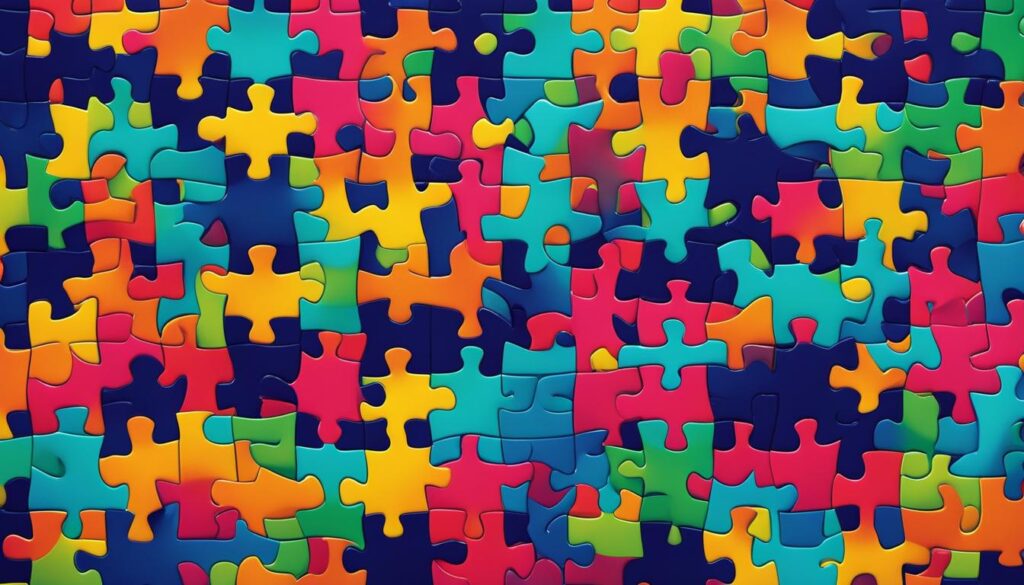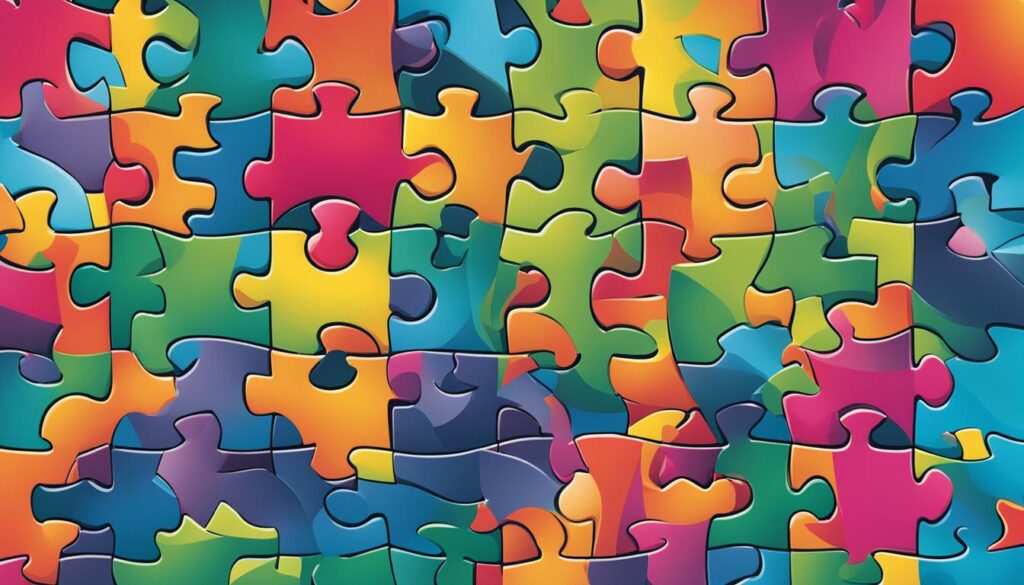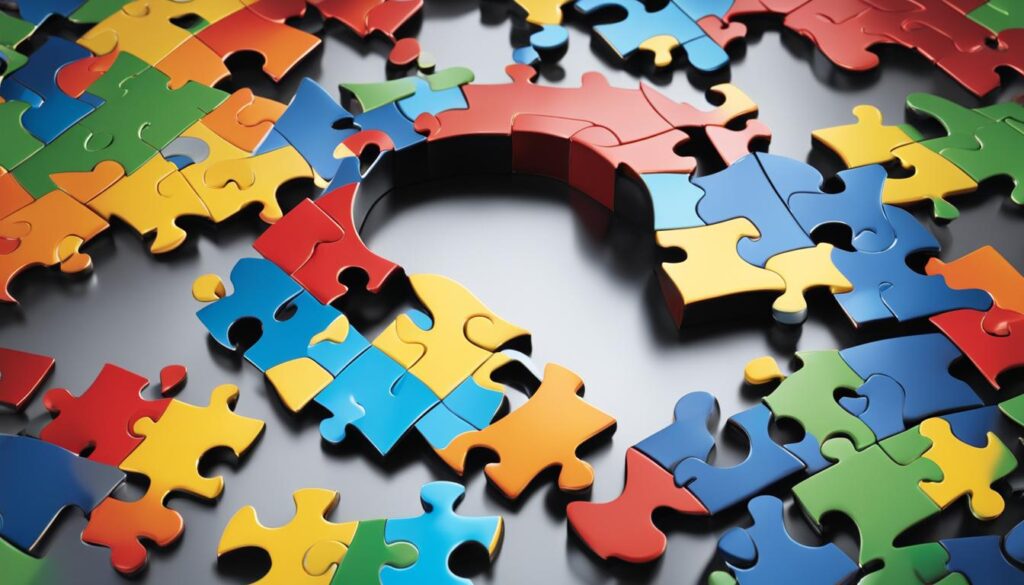Autism is a complex neurological condition that affects millions of individuals around the world. While it presents certain challenges, it is important to recognize that autism does not define a person’s intelligence or potential. In fact, many individuals with autism possess exceptional skills and talents that set them apart.
When it comes to intelligence, autism exists on a spectrum. Some individuals with high-functioning autism demonstrate remarkable abilities in specific areas such as mathematics, technology, and music. These individuals, often referred to as autistic geniuses, possess an incredible capacity for learning and problem-solving that can rival anyone in their field.
Key Takeaways:
- Autism does not limit a person’s intelligence or potential.
- Many individuals with high-functioning autism have exceptional skills in specific areas.
- Autistic geniuses have made significant contributions in fields such as mathematics, technology, and music.
- Recognition and support of these talents are crucial for unlocking the potential of people with autism.
- A supportive and inclusive society can empower individuals with autism to thrive and redefine success in their own terms.
What is an Autistic Savant?
An autistic savant is a person with autism who possesses exceptional skills or abilities in a specific area. These individuals have talents that are often beyond what is considered typical. From remarkable memory capabilities to extraordinary artistic, mathematical, or musical talents, autistic savants demonstrate the incredible potential that can coexist with autism.
One well-known example of an autistic savant is Kim Peek, who inspired the character in the movie “Rain Man.” Peek had an astonishing memory and was able to recall detailed information from a wide range of subjects. His unique abilities showed the world the remarkable talents that can emerge from individuals on the autism spectrum.
Famous Geniuses with Autism
Autism is not a barrier to success. Many individuals diagnosed with autism or believed to have had autism have made significant contributions in various fields, showcasing their incredible talents and achievements. These geniuses with autism have defied societal expectations and shattered stereotypes, proving that neurodiversity is a strength to be celebrated.
Among these remarkable individuals are:
- Elon Musk: The visionary entrepreneur behind companies like Tesla and SpaceX
- Albert Einstein: The renowned physicist who revolutionized our understanding of the universe
- Isaac Newton: The brilliant mathematician and physicist who formulated the laws of motion
- Charles Darwin: The naturalist who developed the theory of evolution
- Nikola Tesla: The inventor and electrical engineer known for his groundbreaking work in electricity and magnetism
- Thomas Jefferson: The Founding Father of the United States and author of the Declaration of Independence
- Michelangelo: The revered artist and sculptor who created masterpieces like the Sistine Chapel ceiling
- Steve Jobs: The co-founder of Apple Inc. and pioneer of the personal computer revolution
- Alfred Kinsey: The influential sexologist whose research revolutionized our understanding of human sexuality
- Bobby Fischer: The chess prodigy and former World Chess Champion
- Tim Burton: The visionary filmmaker known for his distinctive style and storytelling
- Andy Warhol: The iconic artist and leading figure of the pop art movement
- Stephen Wiltshire: The talented artist with an extraordinary photographic memory for architecture
- Ludwig Wittgenstein: The philosopher whose work greatly impacted the field of analytic philosophy
- Wolfgang Amadeus Mozart: The prodigious composer and musician whose works continue to captivate audiences
These remarkable individuals stand as a testament to the immense potential of individuals with high-functioning autism and the unique perspectives they bring to the world.

How ABA Therapy Helps Autistic Geniuses
Applied behavior analysis (ABA) therapy is a proven and highly effective intervention for individuals on the autism spectrum, including those with exceptional intelligence. ABA therapy focuses on identifying and understanding behavior patterns, and it utilizes evidence-based techniques to bring about positive changes in communication, cognitive abilities, and social interaction.
ABA therapy plays a vital role in helping autistic geniuses unlock their full potential by reducing obstacles and enhancing their strengths. By analyzing and addressing specific communication needs, ABA therapy empowers individuals with autism to develop effective language skills and improve their ability to express themselves confidently.
Furthermore, ABA therapy targets cognitive abilities, such as focus, attention, and memory, which are crucial for maximizing the potential of autistic geniuses. Through structured and individualized interventions, ABA therapy helps strengthen cognitive skills and executive function, enabling individuals to excel in their areas of interest.
Additionally, ABA therapy fosters social interaction skills, allowing autistic geniuses to navigate social situations with greater ease. By teaching appropriate social behaviors and improving social cognition, ABA therapy facilitates meaningful connections and enhances overall quality of life.
One of the key strengths of ABA therapy is its emphasis on identifying the root causes of problem behaviors and replacing them with healthier alternatives. By understanding the triggers and functions of challenging behaviors, ABA therapists develop personalized behavior plans that focus on positive reinforcement and skill-building.
ABA therapy recognizes and celebrates the unique strengths and abilities of individuals with autism, providing them with the necessary tools to thrive. By incorporating ABA therapy into their lives, autistic geniuses can overcome obstacles, showcase their intelligence, and achieve their full potential.
Benefits of ABA Therapy for Autistic Geniuses
| Benefits | Description |
|---|---|
| Improved communication skills | ABA therapy helps individuals with autism enhance their verbal and nonverbal communication abilities, allowing them to express themselves effectively. |
| Enhanced cognitive abilities | ABA therapy targets cognitive skills such as focus, attention, and memory, enabling individuals to optimize their intelligence and cognitive potential. |
| Improved social interaction | ABA therapy teaches individuals with autism essential social skills, fostering meaningful connections and enhancing their social interactions. |
| Reduced problem behaviors | ABA therapy identifies the root causes of problem behaviors and replaces them with healthier alternatives, resulting in a decrease in challenging behaviors. |
ABA therapy, with its comprehensive and individualized approach, offers a powerful framework for empowering autistic geniuses to reach their fullest potential. By leveraging the strengths of individuals with autism and providing them with targeted support, ABA therapy plays a crucial role in enhancing communication, cognitive abilities, and social interaction skills.
The Importance of Setting Communication Goals for Autism
For individuals on the autism spectrum, setting communication goals is crucial in enhancing their verbal and nonverbal communication skills. By establishing clear objectives, individuals with autism can develop more meaningful connections with the world around them. Effective communication goals are specific, measurable, achievable, relevant, and timely (SMART), ensuring they cater to individual needs and milestones.
Addressing the unique challenges and goals associated with autism communication empowers individuals to overcome barriers and build a more connected community. Whether it’s improving social interactions or expressing emotions, setting communication goals provides a roadmap for progress and development.
Through targeted interventions and strategies, individuals with autism can enhance their communication skills and establish a strong foundation for lifelong growth. By acknowledging and supporting these goals, we can create a nurturing environment that celebrates diversity and fosters meaningful connections.
Benefits of Setting Communication Goals:
- Improved verbal and nonverbal communication skills
- Enhanced social interactions and relationships
- Better emotional expression and understanding
- Increased confidence in communication abilities
- Greater independence and autonomy
Example Communication Goal:
To initiate a conversation with a peer and maintain a back-and-forth exchange for at least five turns.
By setting specific communication goals, individuals on the autism spectrum can make significant progress in their communication abilities. These goals should be tailored to their unique strengths, challenges, and developmental stage, ensuring they receive the necessary support and encouragement to succeed.

Image: A child with autism engaging in a conversation with a therapist.
Strategies to Enhance Autism Communication Skills
When it comes to enhancing autism communication skills, implementing effective strategies is crucial. These strategies can help individuals on the spectrum overcome communication challenges and connect more effectively with others. By utilizing communication boards, leveraging assistive communication devices, and fostering an understanding of diverse communication styles, individuals with autism can develop their communication skills and build meaningful connections.
Communication Boards:
Communication boards are visual tools that can assist individuals with autism in expressing their thoughts, needs, and preferences. These boards contain pictures, symbols, or words that the individual can point to or select to communicate. Communication boards provide a structured and organized way to convey information, allowing for clearer and more effective communication.
Assistive Communication Devices:
Assistive communication devices are technological tools designed to support communication for individuals with autism. These devices can range from simple augmentative and alternative communication (AAC) devices with pre-programmed messages to more sophisticated devices that offer voice output and customizable communication options. Assistive communication devices empower individuals with autism to express themselves independently and effectively.
Diverse Communication Styles:
Recognizing and understanding diverse communication styles is essential in enhancing autism communication skills. Autism encompasses a wide range of communication strengths and challenges, and individuals on the spectrum may have unique preferences and approaches to communication. By respecting and accommodating these differences, we can create a more inclusive and supportive communication environment.

Tools for Nonverbal Autism Communication
Nonverbal communication is a unique aspect of autism that requires special consideration. For individuals on the spectrum who have difficulty with speech, understanding and interpreting nonverbal cues become essential for facilitating meaningful interactions. These nonverbal cues, such as facial expressions, gestures, and body language, convey emotions, intentions, and thoughts.
Communication boards and assistive devices are invaluable tools that provide visual and tangible ways for nonverbal individuals to express themselves. These tools offer a bridge between their internal world and the external environment, breaking down communication barriers and promoting self-expression.
Communication boards consist of a grid with pictures, symbols, or words that represent different concepts, emotions, or activities. Nonverbal individuals can point or gaze at the images on the board to convey their thoughts or needs. By facilitating visual communication, these boards enable nonverbal individuals to actively participate in conversations and engage with others.
Assistive communication devices employ advanced technology to support nonverbal individuals in expressing themselves. These devices can range from basic speech-generating devices with pre-programmed messages to more sophisticated devices integrated with customized communication software. Through touchscreens, eye-tracking systems, or switch access, nonverbal individuals can select and convey their thoughts, choices, and desires.
Introducing these tools for nonverbal autism communication empowers individuals to have a voice, be understood, and actively participate in social interactions. By embracing these tools, we enable a more inclusive communication environment, fostering connections and creating opportunities for self-expression.

Nurturing Interpersonal Connections through Social Communication Goals
Social communication goals play a crucial role in fostering meaningful interpersonal connections for individuals on the autism spectrum. By setting specific goals, we can help them develop a deeper understanding of social interactions and relationships. Emphasizing the importance of social communication creates a supportive and inclusive community where individuals with autism can thrive socially.
Developing social communication goals involves identifying areas of improvement and tailoring strategies to address specific challenges. These goals encompass verbal and nonverbal communication skills, social cues interpretation, and fostering empathy and understanding.
One effective strategy is the use of visual supports to enhance social communication. This includes visual schedules, social stories, and communication boards that provide individuals with autism with structure and guidance in social situations. Visual supports can also help them express their thoughts and emotions, promoting clearer and more effective communication.
“Social communication goals empower individuals with autism to navigate social interactions more confidently, allowing them to form genuine connections and relationships.”
Building upon the strengths and interests of individuals with autism is another vital aspect of fostering interpersonal connections. By recognizing their unique talents and passions, we can create opportunities for social engagement and collaboration. For example, a child with a keen interest in music may benefit from joining a music group where they can interact with peers who share the same passion.
Image:

By nurturing social communication goals and providing support tailored to the unique needs of individuals with autism, we can create an environment that fosters social connections and inclusivity. Together, we can build a more compassionate society where everyone can thrive.
Conclusion
Autism is a diverse spectrum, with individuals who possess unique strengths and talents. Recognizing and nurturing these strengths is essential for unlocking the full potential of people with autism. Through approaches such as ABA therapy, goal-setting, effective communication strategies, and fostering social connections, we can empower autistic individuals to redefine traditional notions of intelligence and success.
By embracing and supporting the strengths of individuals on the autism spectrum, we contribute to creating a more inclusive and accepting society. Autism acceptance is not just about raising awareness; it’s about understanding and appreciating the value that autism brings to the world. When we celebrate and cultivate these strengths, we enable individuals with autism to thrive and make significant contributions to their communities.
Let us continue to prioritize autism acceptance, unlocking autistic potential, and supporting autism strengths. Together, we can create a world where individuals on the spectrum are embraced for their unique abilities and are given the opportunities to lead fulfilling lives.
FAQ
Can individuals with autism be geniuses?
Yes, many individuals with autism possess exceptional abilities and excel in specific areas such as mathematics, technology, and music. Some autistic individuals, known as savants, demonstrate near-superhuman abilities.
Who are some famous geniuses believed to have had autism?
Some famous individuals who have either been diagnosed with autism or are believed to have had autism include Albert Einstein, Isaac Newton, Charles Darwin, Nikola Tesla, and Steve Jobs. Their talents and achievements prove that autism is not a barrier to success.
How can ABA therapy help autistic geniuses?
Applied behavior analysis (ABA) therapy is a highly effective intervention for autistic individuals, including those with exceptional intelligence. ABA therapy helps improve communication, language skills, focus, memory, and social interaction, allowing autistic geniuses to maximize their potential.
Why is setting communication goals important for individuals with autism?
Setting communication goals is crucial for individuals on the autism spectrum as it helps improve verbal and nonverbal communication skills, fostering more meaningful connections with the world. By addressing the unique challenges and goals associated with autism communication, individuals can overcome barriers and build a more connected community.
What strategies can enhance autism communication skills?
Effective strategies to enhance autism communication skills include using communication boards, leveraging assistive communication devices, and fostering an understanding of diverse communication styles. Implementing personalized approaches enables individuals on the spectrum to overcome communication challenges and connect more effectively with others.
How can nonverbal individuals with autism communicate?
Nonverbal communication is a unique aspect of autism that requires special consideration. Understanding and interpreting nonverbal cues play a significant role in facilitating meaningful interactions with nonverbal individuals on the spectrum. Communication boards and assistive devices offer visual and tangible ways for nonverbal individuals to express themselves, breaking down communication barriers and promoting self-expression.
What are social communication goals for individuals with autism?
Social communication goals are essential for fostering meaningful interpersonal connections for individuals on the autism spectrum. Achieving these goals involves developing a deeper understanding of social interactions and relationships, creating a supportive and inclusive community where individuals with autism can thrive socially.
How can we unlock the potential of people with autism?
Autism is a diverse spectrum, and individuals on the spectrum possess a range of strengths and talents. By recognizing and nurturing these strengths, we can unlock the potential of people with autism. ABA therapy, goal-setting, effective communication strategies, and fostering social connections all contribute to empowering autistic individuals to redefine intelligence and success in their unique way.

